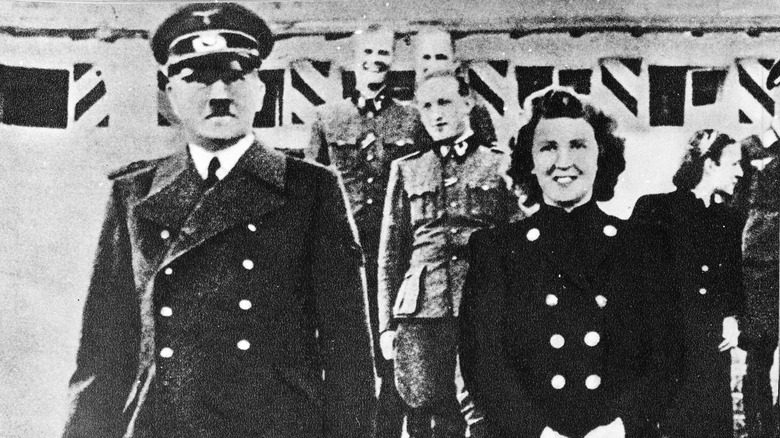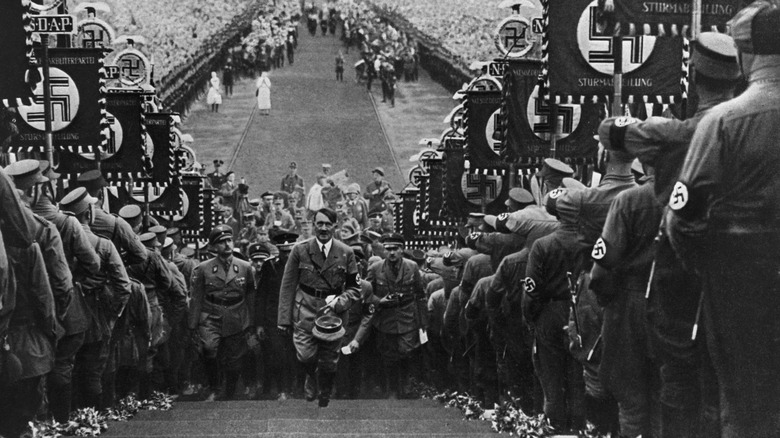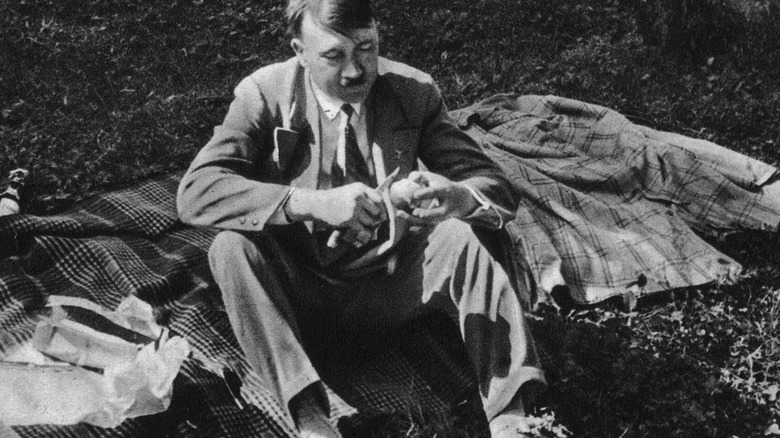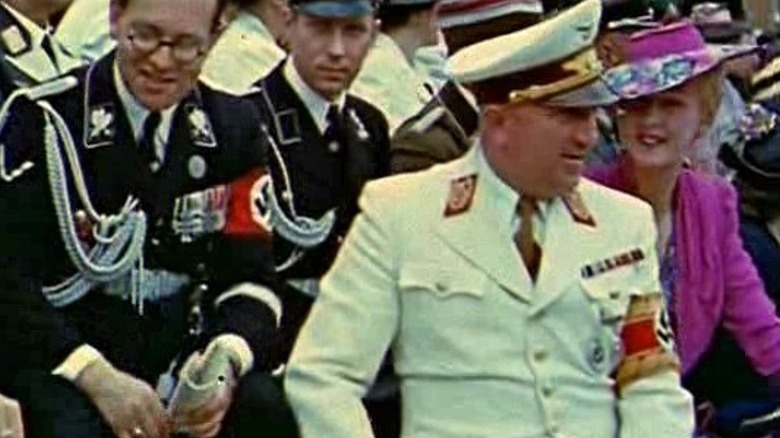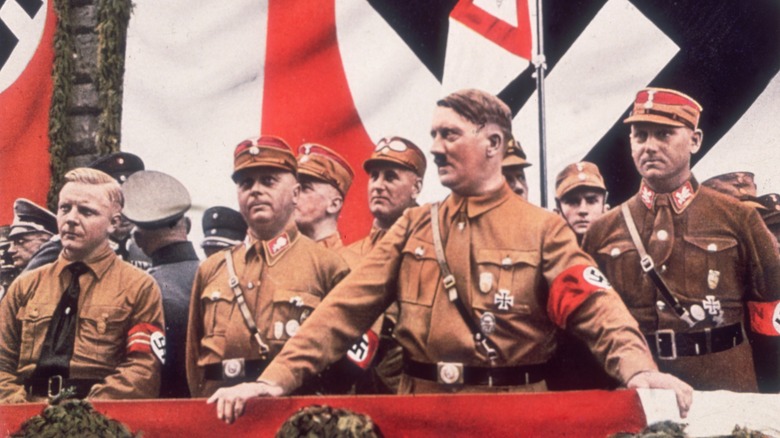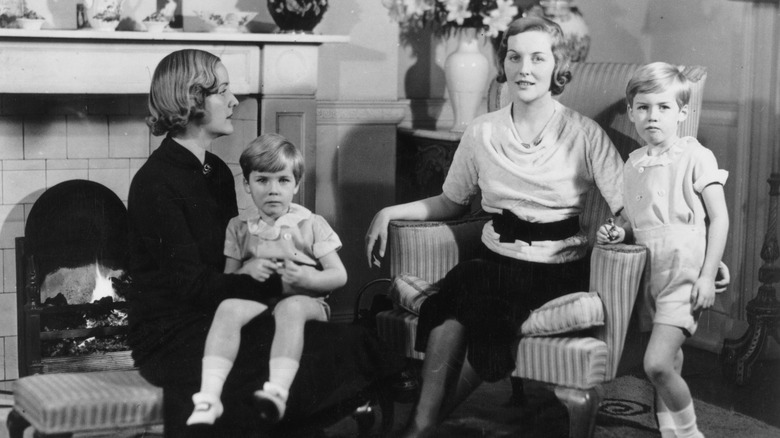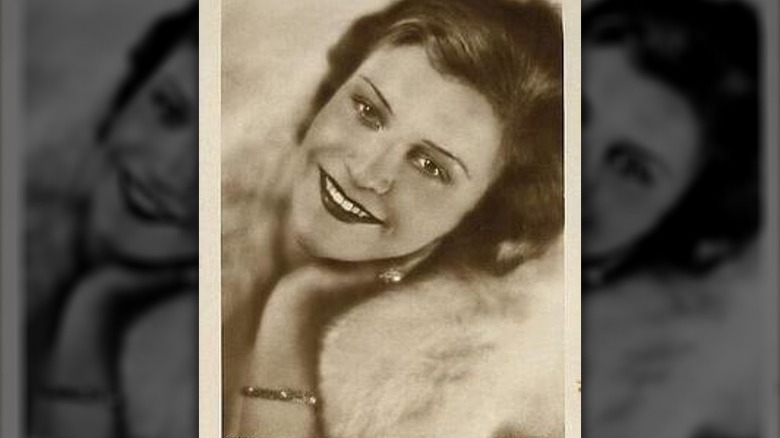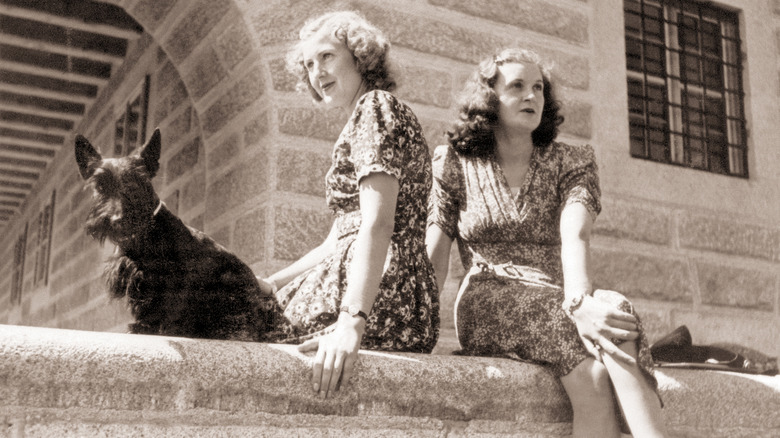The Grim Fates Of Hitler's Lovers
Winston Churchill famously described the end of Adolf Hitler's reign of terror: "The bodies were burnt in the courtyard, and Hitler's funeral pyre, with the din of the Russian guns growing ever louder, made a lurid end of the Third Reich."
Hitler died by suicide in his underground bunker. At his side was his longtime mistress and recent wife Eva Braun, the most famous woman connected to the Third Reich's Fuhrer. As high-profile as she's been, she's surprisingly enigmatic: According to The National WWII Museum, it wasn't until the 2020 book "Eva Braun: Life with Hitler" was released that historians were presented with a version of her that was considerably different than the one that Hitler's cronies unfailingly described as "empty-headed." Instead, author Heike B. Gortemaker argues that Braun knew exactly what she was doing, and what strings to pull.
Hitler's love life has been the subject of considerable speculation, and Braun was far from the only woman associated with him. Perhaps predictably, there's a trend in the women that he was seen with, and that's a grisly end. So, who were they, what was their relationship to the dictator, and what happened to them? History is a little unclear on some of the details, but let's talk about what we do know.
This article contains multiple references to suicide and attempted suicide. If you or anyone you know is having suicidal thoughts, please call the National Suicide Prevention Lifeline by dialing 988 or by calling 1-800-273-TALK (8255).
The woman Hitler's sister described as his one-and-only
Adolf Hitler's sister, Paula, is possibly the only reason anyone remembers his obsession with a 16-year-old girl named Maria Reiter. Paula was being interviewed by a man named Gunter Peis when she referenced Reiter, and when Peis tracked Reiter down post-war, he found that she had letters that proved the story was real.
Their relationship went all the way back to 1926, when the 37-year-old Hitler started courting the teenager. Peis described (via Spiegel) finding and meeting Reiter in the years after the Second World War: She confided in him that although she found Hitler's moustache a little ridiculous she still told her sister, "He looks so dashing, with his boots and his riding crop. He really is an imposing figure." Originally refusing to kiss him, she recalled, "Hitler kept looking at me in shock. ... I felt his fists clench. I saw him struggling with himself. 'Child,' he said, 'I could crush you right now, right now.' I stopped resisting."
With Hitler's rise to power, Nazi party powers-that-be insisted he not see her anymore. By the time their relationship broke off, she was head-over-heels for him and distraught, and attempted suicide. She married before running away back to Hitler, but declined the offer he'd later extend to Eva Braun: become his mistress. Instead, she married a second time to an SS man named Kubisch, and when he died at Dunkirk, Hitler sent her 100 roses... and a summons, which she declined.
Hitler's half-niece and one of history's great mysteries
Angela "Geli" Raubal was the daughter of Adolf Hitler's half-sister, and — much to the chagrin of his party members — his obsession. Hitler was frequently seen out and around town with Raubal on his arm, but when Vanity Fair did a deep dive into the story of Hitler's obsession with his half-niece, they found that there were more things that weren't known than were. Even her hair color is highly debated.
The biggest mystery surrounds her death: Her body was discovered in Hitler's apartment on September 9, 1931. She had been shot in the chest, and the gun that was near her body was Hitler's. Her death was officially ruled to be a suicide, but historian and art dealer Hans Horvath didn't buy it. He, in fact, raised a very interesting question: If she had died by suicide, why was she permitted a burial in a Catholic cemetery, where the burials of suicides are forbidden by religious doctrine?
Hitler's cronies came to his defense to give him an alibi for the night she died, but just what happened has been a long-standing mystery fueled by details like the claims her nose was broken not long before she was killed. Did Hitler murder her for revealing intimate details of their relationship to outsiders? That's one of the popular theories, but attempts at exhuming her body were hampered by the fact that at one point she was moved from the elaborate burial place Hitler secured for her to a pauper's grave.
The opera singer
Inga (or Inge) Ley was born into the opera, and followed her parents to the stage. She was performing in Berlin when she met the man who would become her husband (pictured with her), but in the years leading up to their marriage, they made the acquaintance of the Wagner-obsessed Adolf Hitler.
Hitler remained a pretty regular member of their little family: In addition to giving them a massive lump sum of money and popping by their Berlin residence a few times a week, it's also worth noting that he opened the doors of his own home to Inga — who would stay with him fairly frequently, reportedly to get a break from her husband's drinking. What happened behind those closed doors is unclear. Just what was their relationship? According to Robert G.L. Waite, biographer and author of "The Psychopathic God," Inga did have an affair with Hitler. Details, however, are scarce. (It's worth noting that Inga and Robert's middle child was named Wolf — the same nickname that Hitler reveled in, and insisted Maria Reiter call him.)
Inga was 26 years old and addicted to morphine — first prescribed to manage the pain from a gall bladder condition — when she died by suicide as she and her husband waited for a car to arrive that would take him to Hitler's headquarters.
The mysterious married lady
Historians hoping to get a glimpse behind the curtain, as it were, into Adolf Hitler's psyche have long been obsessed with his sex life — and there's no consensus as to just what kind of guy he was. Theories suggest he was secretly gay, while others suggest he was into the sort of things that show up in textbooks more often than in the real world. His half-niece Geli Raubal's tearful confession to a one-time Nazi insider seemed to give those who subscribed to the theory that Hitler was into some seriously off-the-beaten-path sort of stuff their ammunition, but just as interesting are the things that history has only hints of.
When Robert G.L. Waite published his Hitler biography "The Psychopathic God," he included references to the various women the dictator was involved with. Along with documenting the claim that one German film director had kept him supplied with a series of one-night stands, Waite included mentions of a few other, apparently longer affairs — including an ill-fated one with a woman named Suzi Liptauer.
Waite makes only a single mention of her, writing, "Hitler had an affair with a young married woman, Suzi Liptauer, who, after one strange encounter, tried to hang herself in a Munich hotel." Mainstream history outside of his research, however, seems to have forgotten her, and there is no further information on who she was, what her ultimate fate was, and what happened during their affair.
The British socialite
Historians can't decide on just what the relationship was when it comes to Adolf Hitler and British socialite Unity Mitford (left). What they can agree on is that she spend several years in Nazi Germany, attempted suicide, and was returned to Britain ... and Britain didn't know what to do with her. According to the BBC, she was installed in a vicarage where she was nursed back to health by the vicar's wife, and at the same time, bars were installed on the windows of her room.
While some historians think that Mitford never got past the "platonic acquaintance" stage, others think there was much more going on there — including Eva Braun. She wrote in her journal, "She is known as the Valkyrie and looks the part, including her legs. I, the mistress of the greatest man in Germany and the whole world, I sit here waiting while the sun mocks me through the window panes." Mitford had apparently spent months visiting the same café Hitler was known to frequent, waiting to be noticed. When she was, she impressed him so much with her middle name — Valkyrie — and her wildly anti-Semitic views that he installed her in a Munich apartment.
Giles Milton, author of "When Hitler Took Cocaine," says (via The History Reader) that Mitford was living in Germany when Britain declared war, and — despondent over what would spell the end of her chances at stepping up and displacing Eva Braun — she attempted suicide. She ultimately died in 1948, after developing meningitis as a direct result of her attempt.
The actress who confessed their darkest secrets
Renate Muller was already a well-known movie actress when Adolf Hitler glimpsed her while she was filming, and what followed was... weird. In 1936 — four years after they met — she sat down with a director-turned-confidant and shared what had happened between them, starting with Hitler's relentless awkwardness. "He sat there, not moving at all, looking at me all the time, and then he'd take my hand in his and look some more. He talked all the time — just nonsense," she said.
On one evening, Muller said she had met him for dinner when he ordered her to strip, did the same himself, then lay on the floor and ordered her to kick and whip him. She really wasn't into that sort of thing, but her attempts at going about her own life after that incident failed miserably.
That was at no time more apparent than when she found the Gestapo trailing her on vacation; she met up with another man, was blacklisted on her return to Germany, and things spiraled. After becoming addicted to morphine, she was committed to a sanatorium and it was there that she died by suicide after seeing the arrival of a car full of Gestapo agents. According to Ronald Hayman's "Hitler + Geli," her death came five years after she first met Hitler, and although the circumstances around what, exactly, had happened to her are murky, historians suggest that Hitler had ultimately been afraid that details of their private life would be made public.
Hitler's mistress and the most famous woman of the Third Reich
Eva Braun (left, with her sister) is the most famous woman associated with Adolf Hitler, and died alongside him. The beginning of her relationship with Hitler is perhaps less known: According to The Guardian, she was an assistant working for the photographer largely credited for crafting Hitler's image and she was apparently enough of a Geli Raubal lookalike that she could serve as the replacement for Hitler's half-niece after Raubal died, which Braun did.
Entirely besotted with the dictator, she often lamented the fact that he was off doing other things — like planning the extermination of millions of people — to pay much attention to her, and HistoryToday says that her way of getting attention was to attempt suicide. She did it twice, in 1932 and 1935. In 1944, she wrote a passionate declaration to Hitler: "From the time of our first meetings, I promised myself to follow you anywhere even in death. You know that my whole life is loving you."
Braun was one of the women featured in a book called "What She Ate," (via NPR) and according to author Laura Shapiro, the only time Braun was allowed to be seen in Hitler's company was when they hosted his inner circle. There, too, was where she gained the sympathy of the architect Albert Speer, who saw her as "this unhappy woman, who was so deeply attached to Hitler." At the end of her life, she famously said she simply wanted to leave behind a beautiful corpse.
